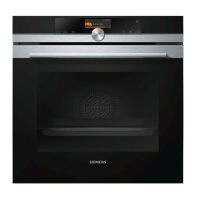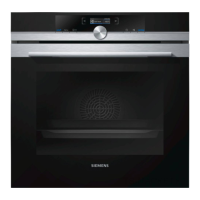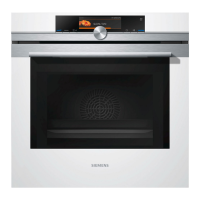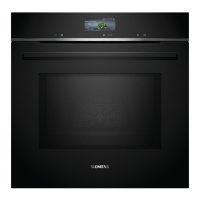How it works en
45
Low-temperature cooking poultry or meat
Note:When using the low-temperature cooking type of
heating, you cannot delay the start of the programme
by setting an end time.
Requirement:The cooking compartment is cold.
1.
Use fresh, hygienically perfect meat. Pieces without
bones and without a lot of connective tissue are
most suitable.
2.
Place the cookware onto the wire rack at level 2 in
the cooking compartment.
3.
Preheat the cooking compartment and cookware for
approx. 15minutes.
4.
Sear the meat on all sides on the hob at a very high
heat.
5.
Immediately place the meat into the pre-warmed
cookware in the cooking compartment.
To ensure that the temperature in the cooking com-
partment remains constant, keep the cooking com-
partment door closed during low-temperature cook-
ing.
Tips for low-temperature cooking
Here you will find tips for achieving good results when
low-temperature cooking food.
Issue Tip
You want to cook a
duck breast at a low
temperature.
¡ Place the cold duck breast
into a pan.
¡ Sear the skin side first.
¡ Cook the duck breast at low
temperature.
¡ After low-temperature cook-
ing, grill the duck breast for
3 to 5minutes until crispy.
You want to serve
your low-temperat-
ure cooked meat as
hot as possible.
¡ Preheat the serving plate.
¡ Make sure that the accom-
panying sauces are very hot
when you serve them.
Recommended settings for low-temperature cooking
Food Accessory/
cookware
Height Searing
time in
mins
Type of
heating
Temperat-
ure in °C
Steam
level
Cooking time
in mins
Duck breast, medium
rare, 300g each
Uncovered
cookware
2 6-8 90
1
- 45-60
Fillet of pork, whole Uncovered
cookware
2 4-6 80
1
- 45-70
Fillet of beef, 1kg Uncovered
cookware
2 4-6 80
1
- 90-120
Veal medallions,
4cm thick
Uncovered
cookware
2 4 80
1
- 30-50
Saddle of lamb,
boned, 200g each
Uncovered
cookware
2 4 80
1
- 30-45
1
Preheat the appliance.
Sterilisation and hygiene
You can sterilise heat-resistant cookware or baby
bottles that are in perfect condition. The process is
equivalent to normal sterilisation by boiling.
Sterilising bottles
1.
Clean the bottles with a bottle brush immediately
after use.
2.
Wash the bottles in the dishwasher.
3.
Place the bottles into the steaming tray (size XL) in
such a way that they do not touch one another.
4.
Start the "Sterilise" programme.
5.
Dry the bottles with a clean cloth.
6.
Wipe down the appliance interior after sterilising.
Useful information on sterilising
Please take note of the following information if you are
sterilising cookware.
¡ You can use your appliance to prepare jam jars or
preserving jars and their lids.
¡ You can perform an additional processing step at
the end in order to improve the jam's shelf life.
¡ Sterilise only heat-resistant cookware that is suitable
for cooking with steam.
¡ Only use clean jars and lids that are in perfect con-
dition.
¡ Ideally, you should wash the cookware in the dish-
washer before sterilising it.
Recommended settings for hygiene
Food Accessory/cook-
ware
Height Type of
heating
→Page9
Temperature in
°C
Steam in-
tensity
Cooking time
in mins
Sterilise clean cookware Perforated steam-
ing tray
2 100 - 15-20

